While ocean giants like whales and sharks often steal the spotlight, let's not forget the strange sea creatures lurking below. From ancient crinoids and striking coral shrimpfish to vibrant peacock mantis shrimp and the downright bizarre hairy frogfish, the ocean is home to many weird and wonderful inhabitants. Whether in Indonesia's Lembeh Strait or Australia's Great Barrier Reef, these critters are just as unusual as they sound. And with over 80 percent of the ocean still unexplored, we're sure there's plenty more to discover. Read on for our roundup of the top five strange sea creatures...
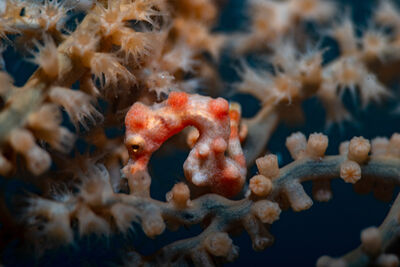
Denise’s pygmy seahorses
Denise's pygmy seahorses kick off our list of strange sea creatures. Proof that good things come in small packages, they're among the tiniest species of seahorse. Named after diver and photojournalist Denise Tackett, who pioneered muck diving in Indonesia's Lembeh Strait, Denise's pygmy seahorses (or hippocampus denise) were officially described in a 2003 scientific paper.
Appearance-wise, these small creatures have thin, fleshy bodies with long necks and elevated crowns. Masters of disguise, their signature orange colour helps them camouflage perfectly with coral. So, where can you spot them? Denise's pygmy seahorses have been found in Indonesia's Raja Ampat, Sulawesi and Triton Bay, as well as the Philippines, Malaysia and northern Australia.
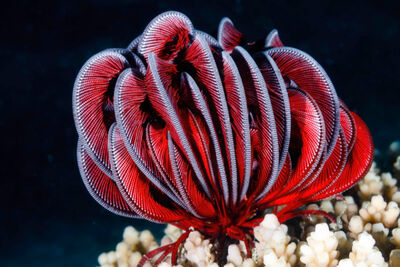
Crinoids
When it comes to crinoids, looks can be deceiving. Despite their plant-like appearance, they're actually animals - and some of the ocean's oldest, at that. Often described by scientists as 'living fossils', these strange sea creatures appeared over 500 million years ago (even before dinosaurs). They are small, colourful animals with disc-shaped bodies, tiny legs and feather-like arms.
Although they seem delicate, crinoids are surprisingly robust with fully functional digestive and nervous systems. They also provide shelter for fish and invertebrates. Part of the echinoderm family, crinoids are found in coral reefs and deep-sea trenches worldwide, from Grenada and Bonaire to Indonesia, Tanzania and Papua New Guinea.
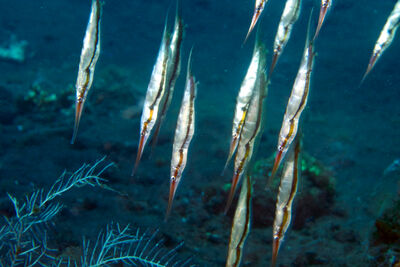
Coral shrimpfish
The clue's in the name with coral shrimpfish. Found near the base of coral reefs (think branching coral and gorgonians) and in seagrass beds, they live at depths ranging from two to 42m. Also known as striped razorfish, these strange sea creatures have slender, streamlined bodies with a dark stripe and a joint in their spine. They travel in synchronised schools, often upside down and turn sideways when faced with potential predators. Found sheltering between the spines of sea urchins, coral shrimpfish can be spotted in the waters of Papua New Guinea, Indonesia, the Philippines, Malaysia and the Solomon Islands.
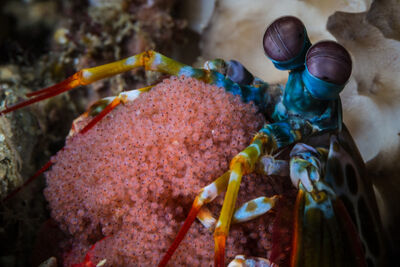
Peacock mantis shrimp
Peacock mantis shrimp are brightly coloured crustaceans, characterised by their large, bulging eyes. With at least 12 types of photoreceptors that can move independently of each other, they have top-notch vision. Although they're not the strongest swimmers, they scurry along the ocean floor and can unfurl their club-like appendages (which fold beneath their bodies) to deliver a punch 50 times faster than the blink of an eye. Talk about speedy.
When they're not hunting prey, peacock mantis shrimp dig burrows to take refuge. They inhabit the shallow waters of the Indian and Pacific Oceans, from the Seychelles, Maldives and Madagascar to the Great Barrier Reef, French Polynesia and Fiji.
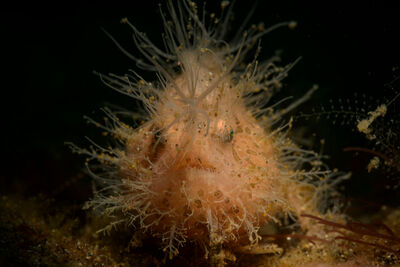
Hairy frogfish
Hairy frogfish are last on our list of strange sea creatures. Despite the name, their 'hairs' are actually skin appendages that help them to blend into their environment. Also known as striated frogfish, these powerful predators can open their mouths wide enough to suck in prey much larger than they are - all without the need to chew.
As experts in camouflage, hairy frogfish can change colour to disappear into their surroundings; in the Lembeh Strait, they often disguise themselves as seaweed. Beyond Indonesia, they can also be found in Anilao and Dumaguete in the Philippines, as well as Fiji and Papua New Guinea.
















